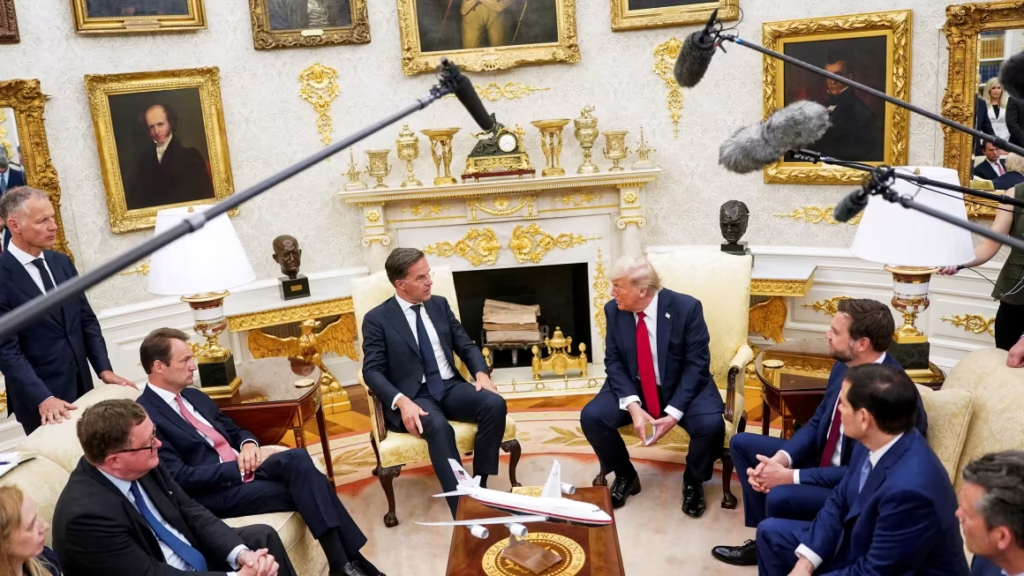

To understand the significant change in former President Donald Trump’s approach to Ukraine, consider two starkly different moments in the Oval Office, months apart
In late February, Trump openly criticized Ukrainian President Volodymyr Zelensky in front of the press, insisting that Ukraine had “no cards left to play” and should seek peace with Russia—largely on Moscow’s terms. Shortly after, the U.S. halted military and intelligence aid to Kyiv.
By mid-July, however, Trump’s tone had shifted dramatically. Meeting with NATO Secretary General Mark Rutte, he announced a major new military aid package for Ukraine, including advanced air defense systems, alongside fresh sanctions on Russia set to take effect in 50 days—unless Vladimir Putin ended the war.
These contrasting scenes mark the end of an ineffective diplomatic phase and the start of a more assertive strategy: one that uses leverage to pressure Russia into ending a conflict Putin has shown no willingness to stop.
The Limits of Diplomacy Without Strength
Theodore Roosevelt famously said, “Diplomacy is utterly useless where there is no force behind it.” This rings especially true in dealing with Russia—a lesson I learned firsthand as an envoy under Presidents Obama and Trump.
While leading U.S. efforts against ISIS in Syria, I engaged in tense diplomatic talks with Russian officials over Moscow’s support for Bashar al-Assad’s regime. Our goal was to avoid clashes between U.S. and Russian forces as we fought ISIS, but the Russians repeatedly tested our resolve.
My counterpart, Alexander Lavrentiev—a close Putin ally—often made reassuring promises during negotiations, agreeing to ceasefires and mapping out zones to prevent direct conflict. Yet on the ground, Russian forces frequently violated these agreements, conducting airstrikes near U.S.-backed Syrian troops or probing our defenses.
The situation escalated in early 2018 near Raqqa, a key city recently liberated from ISIS. We had warned Russia not to cross the Euphrates River, a natural boundary in Syria. Ignoring this, Russian-linked Wagner Group mercenaries advanced toward U.S. positions. After repeated warnings went unheeded, American forces destroyed the column in self-defense.
At our next meeting, Lavrentiev never mentioned the incident—but suddenly, Russia respected the boundaries we had set. As one of my team’s Russia experts put it, “The Russians see diplomacy like a bear dancing: they decide when it ends unless the other dancer proves to be the bigger bear.”
Why Putin Tests American Resolve
In Ukraine, as in Syria, Putin believes he holds the advantage in prolonged conflicts. He sees Washington as distracted by shifting politics and lacking long-term commitment—while Moscow remains relentless. Correcting this perception is key to effective diplomacy.
Trump’s initial approach—pressuring Ukraine to negotiate while dialing back support—only reinforced Putin’s belief that time was on his side. Early in his term, Trump’s team suggested Russia’s invasion was provoked by NATO expansion, ignoring the reality that Putin launched an unprovoked war aimed at conquering Ukraine. This flawed premise led to a strategy of offering concessions, such as taking NATO membership off the table for Kyiv, while reducing military aid.
But the latest shift—arming Ukraine while threatening tougher sanctions—signals a tougher stance. By combining military support with clear consequences for Moscow, the U.S. can reshape Putin’s calculus.
A New Path Forward
The lesson from Syria is clear: diplomacy only works when backed by strength. Putin respects power, not pleas. The new U.S. strategy, pairing advanced weapons for Ukraine with economic pressure on Russia, may finally force him to the negotiating table—not out of goodwill, but because continuing the war becomes too costly.
For Ukraine to secure a lasting peace, America must remain the “bigger bear” in this diplomatic dance. The alternative—wavering support and half-measures—only emboldens Putin to keep fighting.





